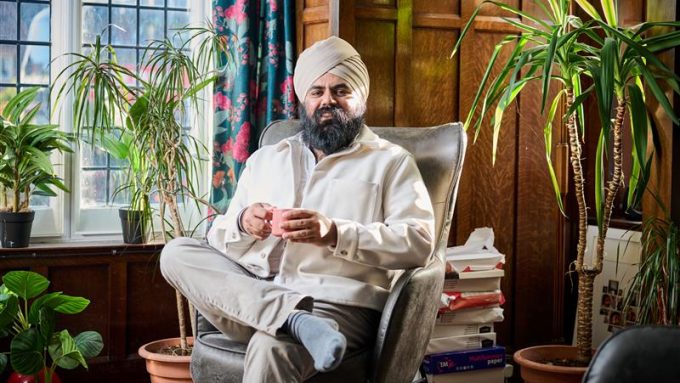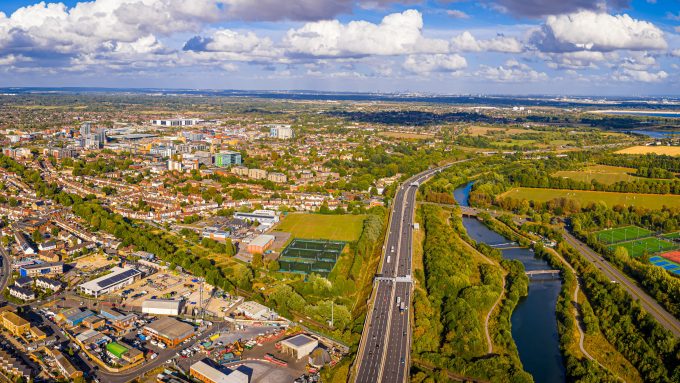
Glasgow showcase explores digital twins’ expanding role at airports

“We need to get better at how we tell stories that deliver value, in a way that people understand,” remarked Justin Anderson, Director of the Digital Twin Hub to an audience in Glasgow in early May. “The story becomes difficult to tell if we use too much technical language.”
Justin was addressing a Digital Twin showcase associated with the Connected Airport Living Lab programme; convened by Connected Places Catapult in association with Glasgow Airport. The programme includes a digital twin competition which is exploring how five innovative businesses could apply their technologies in an aviation environment to improve passenger mobility, energy management and asset replacement.

He added that infrastructure projects need to incorporate “digital twin thinking” well before they are built “to make sure that when we build an asset, we can inform decision-making at an early stage and create value. Our role is to help guide people on that journey; combining different technologies to create a vision of what a digital twin can do.”
But that message could be diluted, he suggested, if too much focus is placed on the specific technologies that lie behind this approach, such as artificial intelligence or machine learning.
Justin made his comments during a ‘fireside chat’ panel discussion on the value of digital twins in aviation, alongside contributors from Glasgow operator AGS Airports and consultant AtkinsRéalis.
He also described digital twins as a virtual representation of the physical world, with these two ‘baseplates’ fitting together to help address challenges in aviation, such as a transition to greener energy or efforts to accommodate a growth in passenger numbers at an airport.
But getting better at aligning physical and digital worlds may require some legislation to compel asset owners to use digital twins in their operations, he added.
“We need a carrot and a whip,” Justin continued. “The reality of collaboration is you can get parties together, but they won’t always agree. Sometimes you need the whip, and that is why you need legislation to drive certain types of behaviour among asset owners so that we can connect the dots.”
The Digital Twin Hub is increasingly seen as a useful platform to advance the twinning agenda, he added. But getting organisations such as local authorities to agree to standard data sharing agreements “can be an impossible task”.
“Tying together systems of systems will deliver huge value for the country, impact policy and create more opportunity for SMEs to come forward with great innovation.”

Competition addresses challenges and barriers
Chairing the fireside chat, Connected Places Catapult’s Ecosystem Director for Air Mobility & Airports, Andrew Chadwick explained that the Living Lab is an innovation hub that aims to address “challenges and barriers in aviation covering decarbonisation, the passenger experience, freight management, automation, data analytics and how we connect airports to the rest of the transport network”.
Andrew asked AGS Airports’ Director of Transformation, Jon Matthews how he sees the use of digital twins contributing to improving passenger mobility and efficiency.
“Critically, we are looking for a digital twin to improve our data intelligence for enhancing the passenger journey,” he replied. “We want to build on previous digital twin initiatives, including a project from 2019 when we digitalised the baggage system at Aberdeen Airport.AGS Airports’ Director of Transformation, Jon Matthews
“A huge value creation opportunity is for digital twins to create multi-dimensional scenario planning much more quickly and accurately than today's largely manual effort.”
Jon added that digital twins “can mean different things to different people” and so any solution put forward using the approach has to be “relatable” to decision makers in order to be successfully taken forward.
Andrew Chadwick turned to Alex Self, the Design Transformation Lead from AtkinsRéalis and asked what digital twin challenges he faced as a supplier.
“In my experience, a digital twin is constrained by both the current effectiveness and adaptability of an organisation’s processes and culture,” replied Alex. “A large organisation like an airport may have a fantastic digital twin, but if its use and outputs are not well integrated into the relevant business processes, decision-making and governance, it is going to struggle to add value.”
He added that currently, the data fed into a digital twin may not always be of the best quality, but it is important to start small, with use cases that can still add value in spite of any current data quality – and not wait until the data is perfect before digitalising workflows.
The event also heard from the Catapult’s Investor Relations Manager Yusuf Chadun who outlined latest developments in the investment landscape. “Testbeds like the Connected Airport Living Lab at Glasgow are incredible opportunities for partnerships, and ensuring that products fit with the market.” he said. “Thank you to the airport for supporting the programme, which helps investors to understand how we are de-risking technologies.”
Aviation cohort speak about the programme
Delegates at the event heard from each of the five small to medium sized enterprises taking part in the digital twin competition, which will see one winner selected to receive up to £70,000 from Connected Places Catapult to trial their innovation at Glasgow Airport.
If selected to trial its technology, Emu Analytics Limited would implement real-time analytics software to monitor aircraft ground movements in order to measure usage of airside taxiways.
Entopy plans to deploy an AI-enabled digital twin platform to alleviate terminal and gate congestion; and IES Ltd wants to deploy digital twin technology to reduce energy consumption and operational costs, and to evaluate long-term decarbonisation scenarios considering future uptake of electric vehicles. OpenSpace Group Ltd is looking to create a real-time digital twin of Glasgow Airport to enhance passenger experience and optimise capacity.
If selected, Consortiq Limited will deploy Unmanned Aerial Systems (UAS) to demonstrate efficient pavement maintenance; maximising the operational lifespan of airport surfaces. High-resolution sensors will capture detailed images, and specialised software will analyse it to identify and assess defects.
Representatives from each of the companies explained how their technology works, and were asked how the programme has been of benefit to them.
Richard Vilton of Emu Analytics said the programme had been a very good way of “raising awareness and connections. It is always hard for companies of our size to get in front of airport and airline operators, so this has been a hugely valuable experience.”
Toby Mills of Entopy said he liked the way the programme had been designed. “We wanted to understand how our technology could overlap from other sectors, and this programme has allowed us to test this and enter useful a dialogue with Glasgow Airport.”
Valeria Ferrando of IES said: “This has been a great opportunity to promote the application of digital twins for an airport environment, to help support their journey to net zero.”
Kate Watt from OpenSpace Group said: “It doesn’t feel like we are competing with others on the programme; it feels like we could all work collaboratively. Being able to move into the aviation industry with our technology is really exciting.”
Ian Rogers of Consortiq added: "We are delighted to take part in the Connected Places Catapult showcase, and demonstrate our UAS operations and data capture capabilities to add real value to airport operations."
Listen to a podcast about the Connected Airport Living Lab programme, or read more. Visit the Digital Twin Hub.





